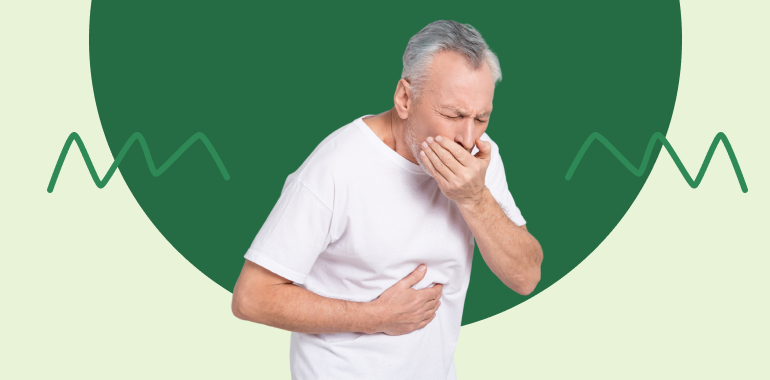Table Of Contents
What is Intermittent Fasting Headache?
Intermittent fasting headache is a type of pain that occurs when people begin fasting or modify their eating schedule. These headaches can range from mild discomfort to severe pain and often come with other symptoms like dizziness or fatigue. While researchers haven’t pinpointed the exact cause, changes in blood sugar levels and dehydration are likely culprits.
The typical fasting headache presents as a throbbing or pulsing sensation in the front, back, or sides of the head. This pain commonly arrives with additional symptoms including fatigue, nausea, and dizziness. Though not usually dangerous on their own, persistent fasting headaches might signal other health concerns that need attention.
During fasting periods, your body taps into stored energy, causing fluctuations in blood sugar levels. When these levels drop too low, headaches often follow. Additionally, many people don’t drink enough water while fasting, leading to dehydration-induced headaches.
Fortunately, most intermittent fasting headaches are temporary and manageable. Staying hydrated, eating balanced meals during your eating window, and gradually extending your fasting duration can help minimize their occurrence. If you experience severe or persistent headaches, however, consulting with a healthcare provider is essential.

How to Prevent Headaches During Intermittent Fasting
Learning how to avoid headaches during intermittent fasting is crucial for a comfortable experience. Here are effective strategies to prevent those painful episodes:
- Stay Hydrated – Drinking adequate water throughout the day prevents dehydration, a major contributor to fasting headaches. Aim for at least eight glasses daily, and consider adding electrolytes during longer fasts.
- Gradually Increase Fasting Duration – If you’re new to fasting, start with shorter periods (12-14 hours) and slowly extend your fasting window as your body adapts. This gradual approach gives your system time to adjust to the new eating pattern.
- Eat a Balanced Diet – During your eating window, focus on nutrient-dense foods that provide steady energy. Include plenty of vegetables, lean proteins, healthy fats, and complex carbohydrates while limiting processed foods and sugar that can trigger blood sugar fluctuations.
- Monitor Caffeine Intake – Caffeine acts as a diuretic and can contribute to dehydration. If you consume coffee or tea during your fast, be mindful of how much you’re drinking and balance it with extra water.
- Take Breaks When Needed – Listen to your body’s signals. If headaches persist despite your best efforts, consider taking a short break from fasting and gradually reintroducing it once symptoms subside.
Also, read – Does Intermittent Fasting Slow Metabolism?
Common Symptoms of Fasting Headaches
Yes, intermittent fasting can trigger headaches in many people. Recognizing these common symptoms can help you identify and address fasting headaches:
- Pain or Pressure in the Head – This can occur on one or both sides and varies in intensity from person to person
- Throbbing or Pulsing Sensations – Many people report rhythmic pain that intensifies with movement
- Light and Sound Sensitivity – Ordinary light and noise may become irritating or painful during a fasting headache
- Nausea and Dizziness – These symptoms often accompany the headache, making daily activities difficult
- Fatigue and Irritability – Energy levels may drop, and mood changes can occur alongside the headache
These symptoms typically stem from changes in fluid balance and shifts in electrolyte levels during fasting periods. Your body experiences alterations in its normal functioning when fasting, potentially triggering dehydration and blood sugar fluctuations that manifest as headaches.
What to Eat for a Hunger Headache
When breaking your fast to relieve a hunger headache, choosing the right foods is crucial. Your goal is to stabilize blood sugar levels without causing a rapid spike. Here are effective food choices to address hunger headaches:
→ Whole Foods for Blood Sugar Stability – Opt for fiber-rich fruits, vegetables, and whole grains that provide steady energy release. Items like apples, berries, oatmeal, and sweet potatoes offer nutrients without causing dramatic blood sugar fluctuations.
→ Protein-Rich Options – Including protein helps maintain satiety and blood sugar levels. Good choices include eggs, Greek yogurt, chicken, fish, tofu, or legumes like lentils and chickpeas.
→ Healthy Fats – Foods containing healthy fats like avocados, nuts, seeds, and olive oil help slow digestion and provide sustained energy. A handful of almonds or walnuts can be particularly effective for hunger headaches.
→ Hydrating Foods – Many fruits and vegetables have high water content that helps address dehydration while providing nutrients. Cucumber, watermelon, oranges, and celery are excellent choices that contribute to hydration.
When breaking your fast, I recommend eating slowly and mindfully. Large meals can trigger discomfort, so start with smaller portions. Avoid highly processed carbohydrates and sugary foods that might initially relieve symptoms but ultimately lead to another blood sugar crash.
9 Other Side Effects of Intermittent Fasting & Prevention
Beyond headaches, intermittent fasting can cause several other side effects. Understanding these potential issues and how to prevent them helps create a more comfortable fasting experience:
Dizziness and Lightheadedness
Low blood sugar levels often cause this sensation, especially for fasting beginners. To prevent dizziness, ensure you consume adequate calories and nutrients during your eating window. If lightheadedness occurs, sit down immediately and consider breaking your fast with a small, balanced snack.
Fatigue
Energy levels may drop during fasting periods due to hormonal changes and decreased calorie intake. Prioritize quality sleep during fasting, and consider scheduling demanding activities during your energy peaks. Including iron-rich and B-vitamin foods in your meals helps maintain energy levels.
Nausea
Stomach discomfort can occur when adjusting to fasting. Begin with shorter fasting periods and gradually extend them as your body adapts. Staying hydrated and avoiding lying down immediately after eating can also help minimize nausea.
Irritability
Mood changes and irritability often accompany fasting due to blood sugar fluctuations and hunger. Keep yourself occupied during fasting periods with engaging activities. Balanced eating during your feeding window, with adequate protein and healthy fats, helps stabilize mood.
Constipation
Digestive changes are common when altering eating patterns. Increase fiber intake through fruits, vegetables, and whole grains during your eating window. Stay well-hydrated and consider adding probiotic foods like yogurt to support digestive health.
Hunger
Intense hunger is a natural response to fasting, particularly in the beginning stages. Stay busy with tasks that keep your mind engaged during fasting hours. Ensure your meals contain adequate protein, fiber, and healthy fats to promote fullness when you do eat.
Food Cravings
Specific food cravings, especially for sweets and high-calorie options, often increase during fasting periods. Include sufficient protein and fiber in your meals to reduce cravings. Plan satisfying, nutrient-dense meals that include small portions of foods you enjoy.
Muscle Loss
Extended fasting without adequate protein intake can lead to muscle catabolism. Consume enough protein during your eating window—aim for 1.6-2.2g per kg of body weight daily if you’re active. Incorporate resistance training to maintain and build muscle mass.
Binge Eating
Some people experience intense urges to overeat during their eating window after prolonged restricting food. Plan balanced meals ahead of time to avoid impulsive eating. Start eating windows with protein and vegetables before adding carbohydrates, and practice mindful eating by eating slowly and without distractions.
Maintaining proper nutrition during eating windows helps prevent most fasting side effects. Focus on nutrient-dense whole foods, stay hydrated, and listen to your body’s signals—adjusting your fasting protocol as needed.
5 Best Strategies to Deal With Headaches During Fasting
When headaches strike during your fasting period, these five proven strategies can help provide relief:
1. Stay Properly Hydrated
Dehydration is a major headache trigger during fasting. I recommend drinking at least 8-10 cups of water daily, and possibly more if you’re physically active or in hot weather. Adding electrolytes to your water can be particularly beneficial during longer fasts, as they help maintain proper fluid balance. Spacing your water intake throughout the day rather than consuming large amounts at once helps optimize hydration.
2. Start With Shorter Fasting Windows
For fasting beginners, jumping into extended fasts often triggers headaches. Begin with a manageable 12-14 hour overnight fast, which many find relatively easy as it includes sleeping hours. Gradually extend your fasting window by 30-60 minutes every few days, allowing your body to adapt to the new eating pattern. This gentle progression minimizes headache triggers while your metabolism adjusts to utilizing stored fat for energy.
3. Avoid Known Headache Triggers
Certain substances can increase headache risk during fasting. Limit or eliminate caffeine, alcohol, processed foods, and high-sugar items that may disrupt blood sugar stability. Pay attention to your personal triggers—some people find that artificial sweeteners, MSG, or specific food additives increase headache frequency. Keeping a food and symptom journal can help identify your specific triggers.
4. Manage Stress Through Relaxation Techniques
Stress often intensifies fasting headaches. Implement regular relaxation practices like deep breathing exercises, where you focus on slow, measured breaths for 5-10 minutes. Meditation provides similar benefits by directing attention to positive thoughts or sensations. Gentle yoga combines physical movement with mindful breathing to release tension in head and neck muscles. These stress-reduction techniques lower cortisol levels and can significantly reduce stress-related headache pain.
5. Consider Supplements Like Magnesium and Potassium
Research has suggested that certain minerals may help prevent fasting headaches. Magnesium supplements can relax blood vessels and reduce tension that contributes to headaches. Potassium helps regulate blood pressure and fluid balance, potentially minimizing headache symptoms. Always consult with a healthcare provider before adding any new supplements to your routine, as individual needs vary based on health status and medications.
If headaches persist despite implementing these strategies, consult a healthcare provider to rule out underlying conditions and develop a personalized approach to fasting.
How to Fast Without Getting a Headache When You Already Have One
When you’re already experiencing a headache during your fast, these targeted approaches can help provide relief while maintaining your fasting goals:
➟ Hydrate Immediately
Drink 16-20 ounces of water right away, as dehydration often intensifies existing headaches. Consider adding a pinch of salt to help with electrolyte balance without breaking your fast. Sip water consistently throughout the remainder of your fasting period rather than consuming it all at once.
➟ Eat a Small Nutritious Meal
If your headache becomes severe, consider breaking your fast with a small, balanced meal. Focus on protein and healthy fats like a handful of nuts, a hard-boiled egg, or avocado, which provide steady energy without causing blood sugar spikes. You can always resume fasting after addressing the immediate discomfort.
➟ Reduce Caffeine Consumption
While some find that small amounts of caffeine help headaches, larger amounts can worsen them during fasting. If you regularly consume caffeine, sudden withdrawal might contribute to your headache. Consider a small amount of black coffee or tea if you suspect withdrawal is the cause, but otherwise limit caffeine during fasting periods.
➟ Rest and Practice Relaxation Techniques
Find a quiet, dimly lit space to rest if possible. Practice deep breathing by inhaling slowly through your nose for a count of four, holding briefly, then exhaling through your mouth for a count of six. Gentle neck stretches can also help release tension that contributes to headache pain.
➟ Apply Cold Compresses
Place a cold pack or ice wrapped in a cloth on your forehead, temples, or the back of your neck for 10-15 minutes. The cold helps constrict blood vessels and reduce inflammation that may be contributing to your headache. Alternate with warm compresses if the cold alone doesn’t provide relief.
➟ Try Acupressure Points
Apply firm but gentle pressure to specific points that may help relieve headache pain. The space between your thumb and index finger (LI4 point) and the base of the skull where the neck muscles attach are particularly effective areas. Press and hold these points for 1-2 minutes while taking slow, deep breaths.
➟ Get Fresh Air
A short walk outside or simply sitting near an open window can provide relief. Fresh air and natural light (unless you’re light-sensitive) can help improve oxygen flow and reduce headache intensity. Even 5-10 minutes of gentle movement outside can make a difference.
➟ Maintain Consistent Fasting Schedule
Irregular fasting patterns can trigger headaches. Try to maintain consistent fasting and eating windows day-to-day. Your body adapts better to predictable patterns, reducing the likelihood of headaches over time as your metabolism adjusts to regular fasting intervals.

Managing Fasting Headaches Long-Term
Developing a sustainable approach to prevent recurring fasting headaches requires consistent attention to your body’s responses. These long-term strategies help minimize headache frequency and severity:
Track Your Symptoms and Triggers
Keep a detailed journal documenting when headaches occur in relation to your fasting schedule. Note potential triggers like sleep quality, stress levels, hydration, and specific foods consumed before or after fasting. This systematic tracking helps identify personal patterns that might not be immediately obvious. Over time, you’ll recognize specific conditions that precede your headaches, allowing for preventative measures.
Adjust Your Fasting Protocol
If headaches consistently occur at certain fasting durations, consider modifying your approach. You might benefit from a different fasting schedule—perhaps several shorter fasting periods work better for you than fewer longer ones. Some people find that certain fasting methods like 16:8, 5:2, or alternate-day fasting produce fewer side effects based on their individual physiology. Don’t hesitate to experiment with different protocols until you find one that minimizes headaches.
Prioritize Nutrition During Eating Windows
The quality of food during eating periods significantly impacts how you feel during fasts. Focus on nutrient-dense whole foods rich in magnesium (leafy greens, nuts, seeds), potassium (bananas, avocados, potatoes), and B vitamins (whole grains, eggs, lean meats). These nutrients help support brain function and may reduce headache frequency. Minimize processed foods, excessive sugar, and alcohol that can trigger inflammation and blood sugar instability.
Listen to Your Body’s Signals
Pay attention to early warning signs that might precede a full headache, such as mild tension, slight dizziness, or unusual thirst. Addressing these preliminary symptoms often prevents the development of more severe headaches. Remember that fasting should enhance your wellbeing, not diminish it. If headaches persist despite your best efforts, consider whether your current fasting approach aligns with your body’s needs and health goals.
Consistency with these practices builds resilience over time. Many people find that fasting headaches diminish or disappear entirely as their bodies adapt to regular fasting schedules. However, persistent or severe headaches warrant consultation with a healthcare provider to rule out underlying conditions.
Final Thoughts
Intermittent fasting headaches are genuine concerns that deserve attention when they arise. The connection between fasting and headaches varies from person to person, with symptoms ranging from mild discomfort to debilitating pain. Staying properly hydrated stands as perhaps the most crucial preventive measure, while consulting with your doctor becomes necessary if headaches persist or worsen.
I’ve found that other common side effects like fatigue, irritability, and hunger pangs often accompany these headaches. Each person’s fasting journey looks different, which is why listening to your body and adjusting your approach accordingly matters more than following any rigid protocol.
Maintaining nutritional balance during eating windows significantly impacts how you feel during fasts. Focusing on nutrient-dense whole foods, healthy fats, and adequate protein creates a foundation that minimizes headache risk and other unwanted symptoms.
Recognizing early warning signs of an impending headache allows you to take preventive action. Whether that means increasing water intake, applying cold compresses, or practicing stress-reduction techniques, early intervention often prevents full-blown headaches from developing.
Ultimately, intermittent fasting should enhance your health, not detract from it. If headaches remain a persistent issue despite implementing the strategies outlined in this article, consider modifying your fasting approach or consulting with a healthcare provider for personalized guidance. Your fasting practice should fit your unique body and lifestyle, creating benefits that outweigh any temporary discomforts.
My name is Barbara Kovalenko. I hold a Bachelor's degree in Human Nutrition from Bogomolets National Medical University in Ukraine and a Master's degree from Boston University in the United States. Over the past few years, I have gained valuable experience as a nutritionist and have since decided to share my knowledge and expertise with a wider audience. Currently, I am working as a nutritional consultant with the Lasta app.










Your strategies to combat headaches while fasting are effective. I tried magnesium and it reduced the headaches.
Hello, Kate!
It’s great that you found the information helpful.😊